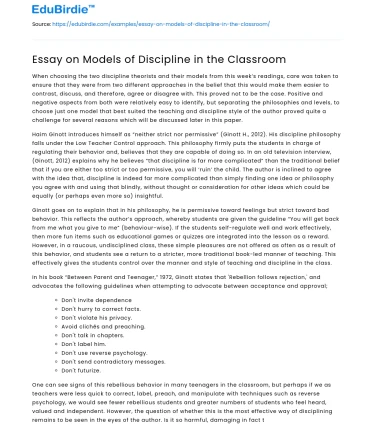When choosing the two discipline theorists and their models from this week’s readings, care was taken to ensure that they were from two different approaches in the belief that this would make them easier to contrast, discuss, and therefore, agree or disagree with. This proved not to be the case. Positive and negative aspects from both were relatively easy to identify, but separating the philosophies and levels, to choose just one model that best suited the teaching and discipline style of the author proved quite a challenge for several reasons which will be discussed later in this paper.
Haim Ginott introduces himself as “neither strict nor permissive” (Ginott H., 2012). His discipline philosophy falls under the Low Teacher Control approach. This philosophy firmly puts the students in charge of regulating their behavior and, believes that they are capable of doing so. In an old television interview, (Ginott, 2012) explains why he believes “that discipline is far more complicated” than the traditional belief that if you are either too strict or too permissive, you will ‘ruin’ the child. The author is inclined to agree with the idea that, discipline is indeed far more complicated than simply finding one idea or philosophy you agree with and using that blindly, without thought or consideration for other ideas which could be equally (or perhaps even more so) insightful.
Ginott goes on to explain that in his philosophy, he is permissive toward feelings but strict toward bad behavior. This reflects the author’s approach, whereby students are given the guideline “You will get back from me what you give to me” (behaviour-wise). If the students self-regulate well and work effectively, then more fun items such as educational games or quizzes are integrated into the lesson as a reward. However, in a raucous, undisciplined class, these simple pleasures are not offered as often as a result of this behavior, and students see a return to a stricter, more traditional book-led manner of teaching. This effectively gives the students control over the manner and style of teaching and discipline in the class.
In his book “Between Parent and Teenager,” 1972, Ginott states that 'Rebellion follows rejection,' and advocates the following guidelines when attempting to advocate between acceptance and approval;
- Don't invite dependence
- Don't hurry to correct facts.
- Don't violate his privacy.
- Avoid clichés and preaching.
- Don't talk in chapters.
- Don't label him.
- Don't use reverse psychology.
- Don't send contradictory messages.
- Don't futurize.
One can see signs of this rebellious behavior in many teenagers in the classroom, but perhaps if we as teachers were less quick to correct, label, preach, and manipulate with techniques such as reverse psychology, we would see fewer rebellious students and greater numbers of students who feel heard, valued and independent. However, the question of whether this is the most effective way of disciplining remains to be seen in the eyes of the author. Is it so harmful, damaging in fact to use the odd cliché or to correct a factual mistake? Or, does this depend more on how this is said or done, rather than that this ‘error’ in technique has been applied at all? Is this not what is implied by Ginott’s idea that when a teacher uses a ‘sane message’ to address the situation as opposed to the character of the student, this leads to better discipline through a series of small ‘victories’?






 Stuck on your essay?
Stuck on your essay?

